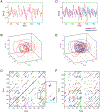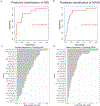Altered Periodic Dynamics in the Default Mode Network in Autism and Attention-Deficit/Hyperactivity Disorder
- PMID: 35227462
- PMCID: PMC9119910
- DOI: 10.1016/j.biopsych.2022.01.010
Altered Periodic Dynamics in the Default Mode Network in Autism and Attention-Deficit/Hyperactivity Disorder
Abstract
Background: Altered resting-state functional connectivity in the default mode network (DMN) is characteristic of both autism spectrum disorder (ASD) and attention-deficit/hyperactivity disorder (ADHD). Standard analytical pipelines for resting-state functional connectivity focus on linear correlations in activation time courses between neural networks or regions of interest. These features may be insensitive to temporally lagged or nonlinear relationships.
Methods: In a twin cohort study comprising 292 children, including 52 with a diagnosis of ASD and 70 with a diagnosis of ADHD, we applied nonlinear analytical methods to characterize periodic dynamics in the DMN. Using recurrence quantification analysis and related methods, we measured the prevalence, duration, and complexity of periodic processes within and between DMN regions of interest. We constructed generalized estimating equations to compare these features between neurotypical children and children with ASD and/or ADHD while controlling for familial relationships, and we leveraged machine learning algorithms to construct models predictive of ASD or ADHD diagnosis.
Results: In within-pair analyses of twins with discordant ASD diagnoses, we found that DMN signal dynamics were significantly different in dizygotic twins but not in monozygotic twins. Considering our full sample, we found that these patterns allowed a robust predictive classification of both ASD (81.0% accuracy; area under the curve = 0.85) and ADHD (82% accuracy; area under the curve = 0.87) cases.
Conclusions: These findings indicate that synchronized periodicity among regions comprising the DMN relates both to neurotypical function and to ASD and/or ADHD, and they suggest generally that a dynamical analysis of network interconnectivity may be a useful methodology for future neuroimaging studies.
Keywords: Attention-deficit/hyperactivity disorder; Autism; Default mode network; Dynamical systems; Recurrence quantification analysis; Resting-state connectivity.
Copyright © 2022 Society of Biological Psychiatry. Published by Elsevier Inc. All rights reserved.
Conflict of interest statement
Competing Interests
The authors report no biomedical financial interests or potential conflicts of interest.
Figures




Comment in
-
Can Chaos Bring Order to the Study of Functional Connectivity in Neurodevelopmental Disorders?Biol Psychiatry. 2022 Jun 1;91(11):918-919. doi: 10.1016/j.biopsych.2022.03.014. Biol Psychiatry. 2022. PMID: 35589312 No abstract available.
References
-
- Fox MD, Raichle ME (2007): Spontaneous fluctuations in brain activity observed with functional magnetic resonance imaging. Nat Rev Neurosci. 8:700–711. - PubMed

